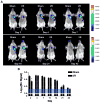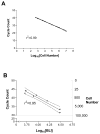In vivo functional and transcriptional profiling of bone marrow stem cells after transplantation into ischemic myocardium
- PMID: 22034515
- PMCID: PMC3241895
- DOI: 10.1161/ATVBAHA.111.238618
In vivo functional and transcriptional profiling of bone marrow stem cells after transplantation into ischemic myocardium
Abstract
Objective: Clinical trials of bone marrow-derived stem cell therapy for the heart have yielded variable results. The basic mechanism(s) that underlies their potential efficacy remains unknown. In the present study, we evaluated the survival kinetics, transcriptional response, and functional outcome of intramyocardial bone marrow mononuclear cell (BMMC) transplantation for cardiac repair in a murine myocardial infarction model.
Methods and results: We used bioluminescence imaging and high-throughput transcriptional profiling to evaluate the in vivo survival kinetics and gene expression changes of transplanted BMMCs after their engraftment into ischemic myocardium. Our results demonstrate short-lived survival of cells following transplant, with less than 1% of cells surviving by 6 weeks posttransplantation. Moreover, transcriptomic analysis of BMMCs revealed nonspecific upregulation of various cell regulatory genes, with a marked downregulation of cell differentiation and maturation pathways. BMMC therapy caused limited improvement of heart function as assessed by echocardiography, invasive hemodynamics, and positron emission tomography. Histological evaluation of cell fate further confirmed findings of the in vivo cell tracking and transcriptomic analysis.
Conclusions: Collectively, these data suggest that BMMC therapy, in its present iteration, may be less efficacious than once thought. Additional refinement of existing cell delivery protocols should be considered to induce better therapeutic efficacy.
Figures









Comment in
-
The changing face and abbreviated lives of bone marrow cells in the heart.Arterioscler Thromb Vasc Biol. 2012 Jan;32(1):1-2. doi: 10.1161/ATVBAHA.111.239921. Arterioscler Thromb Vasc Biol. 2012. PMID: 22173974 No abstract available.
References
-
- Schachinger V, Assmus B, Britten MB, Honold J, Lehmann R, Teupe C, Abolmaali ND, Vogl TJ, Hofmann WK, Martin H, Dimmeler S, Zeiher AM. Transplantation of progenitor cells and regeneration enhancement in acute myocardial infarction: Final one-year results of the topcare-ami trial. J Am Coll Cardiol. 2004;44:1690–1699. - PubMed
-
- Schachinger V, Erbs S, Elsasser A, Haberbosch W, Hambrecht R, Holschermann H, Yu J, Corti R, Mathey DG, Hamm CW, Suselbeck T, Assmus B, Tonn T, Dimmeler S, Zeiher AM. Intracoronary bone marrow-derived progenitor cells in acute myocardial infarction. N Engl J Med. 2006;355:1210–1221. - PubMed
-
- Lunde K, Solheim S, Aakhus S, Arnesen H, Abdelnoor M, Egeland T, Endresen K, Ilebekk A, Mangschau A, Fjeld JG, Smith HJ, Taraldsrud E, Grogaard HK, Bjornerheim R, Brekke M, Muller C, Hopp E, Ragnarsson A, Brinchmann JE, Forfang K. Intracoronary injection of mononuclear bone marrow cells in acute myocardial infarction. N Engl J Med. 2006;355:1199–1209. - PubMed
-
- Wollert KC, Meyer GP, Lotz J, Ringes-Lichtenberg S, Lippolt P, Breidenbach C, Fichtner S, Korte T, Hornig B, Messinger D, Arseniev L, Hertenstein B, Ganser A, Drexler H. Intracoronary autologous bone-marrow cell transfer after myocardial infarction: The boost randomised controlled clinical trial. Lancet. 2004;364:141–148. - PubMed
-
- Meluzin J, Janousek S, Mayer J, Groch L, Hornacek I, Hlinomaz O, Kala P, Panovsky R, Prasek J, Kaminek M, Stanicek J, Klabusay M, Koristek Z, Navratil M, Dusek L, Vinklarkova J. Three-, 6-, and 12-month results of autologous transplantation of mononuclear bone marrow cells in patients with acute myocardial infarction. Int J Cardiol. 2008;128:185–192. - PubMed
Publication types
MeSH terms
Grants and funding
LinkOut - more resources
Full Text Sources

